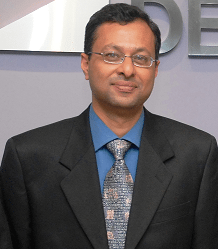Avionics are the electronic systems used on aircraft, satellites and space vehicles that help them in communications navigation and management systems. While navigation in consumer devices is primarily based on the global positioning system, military applications require something that is much more reliable.
Somshubhro Pal Choudhry, MD, Analog Devices and Paul K Klonowski, Global Director, Aerospace & Defence, Analog Devices speaks with Rahul Chopra and Dilin Anand of EFY.

Q. What are the prominent technological trends in avionics?
A. We are seeing an increasing trend and urgency for global positioning system (GPS) denied navigation. The situation arises if during battlefield conditions, either the satellites are not available, jammed or taken down by the enemy. The focus on reduction of size, weight and power continues aggressively specially in the aircrafts to save fuel. We are also seeing an increasing use of Inertial micro-electro-mechanical systems (MEMS) sensors, not just for GPS denied navigation purposes but in variety of functions like auto-pilots for unmanned aerial vehicles (UAVs), platform stabilization and so on. There is increasing use of wireless sensor networks for a mesh network in the battlefield for data communication.

Q. As sensors are one of the most important elements here, could you give an idea as to what the data processing cycle is with sensors?
A. We focus on the process that involves capturing the data from the physical environment, which is in the analogue domain, cleaning up the signal, filtering and amplifying the signal, converting into digital signals and making it ready for making any decision based on the data. Hence these products are the bridge between the analogue or the physical world and the digital domain.
Q. What are the challenges that these next-generation sensors will help resolve in avionics
A. The trend here is that as missiles keep getting smaller, hence miniaturization is needed. Therefore we have to choose smaller packages for incorporating the components that goes into it. These missiles also need to perform in a GPS denied environment. This means that we need to find ways to keep the missile on track even in the case where GPS has been disabled. In order to do so, we work on collecting data like the yaw rate and other data through Inertial MEMS Units (IMUs) in smaller and smaller packages while ensuring higher accuracy. The context here is that in the case of electronic warfare, the GPS and satellites will be taken out immediately, which means you need to rely on extremely accurate inertial sensors and devices.
Q. What’s driving electronics design for avionics?
A. What’s driving avionics is the fact that so much more air travel and growth has been led by Asia, resulting in the demand for even more planes. One major trend in designing for avionics is about saving weight. A very high percentage of the plane is fuel, so if you are able to cut the weight down you will have an obvious saving in fuel consumption. We are working on some advanced technology now, which is in the area of very reliable wireless sensor networks. These would allow non-critical data to be sent via wireless mesh network and hence help reduce the size and weight of the plane due to reduction of cabling.
Q. Could you share some of the most exciting non-combat military applications that you believe the latest sensing technology will help in?
A. Most recently, the demand for UAVs has become more prevalent as their adoption by government defence programs as well as civil use applications is rapidly increasing. Additionally, high quality enhanced vision systems are critical to the defence and aerospace markets. Applications such as gimbal mounted surveillance cameras for aircraft and night vision goggles for soldiers require leading edge image capture, video processing and high speed data link technology. From security perspective, the image and video analytics solutions are turning closed-circuit television (CCTV) cameras into smart cameras, by imparting context aware intelligence to these cameras, so that they can recognize an event (like a security breach at a kiosk) and immediately send out timely alerts.






